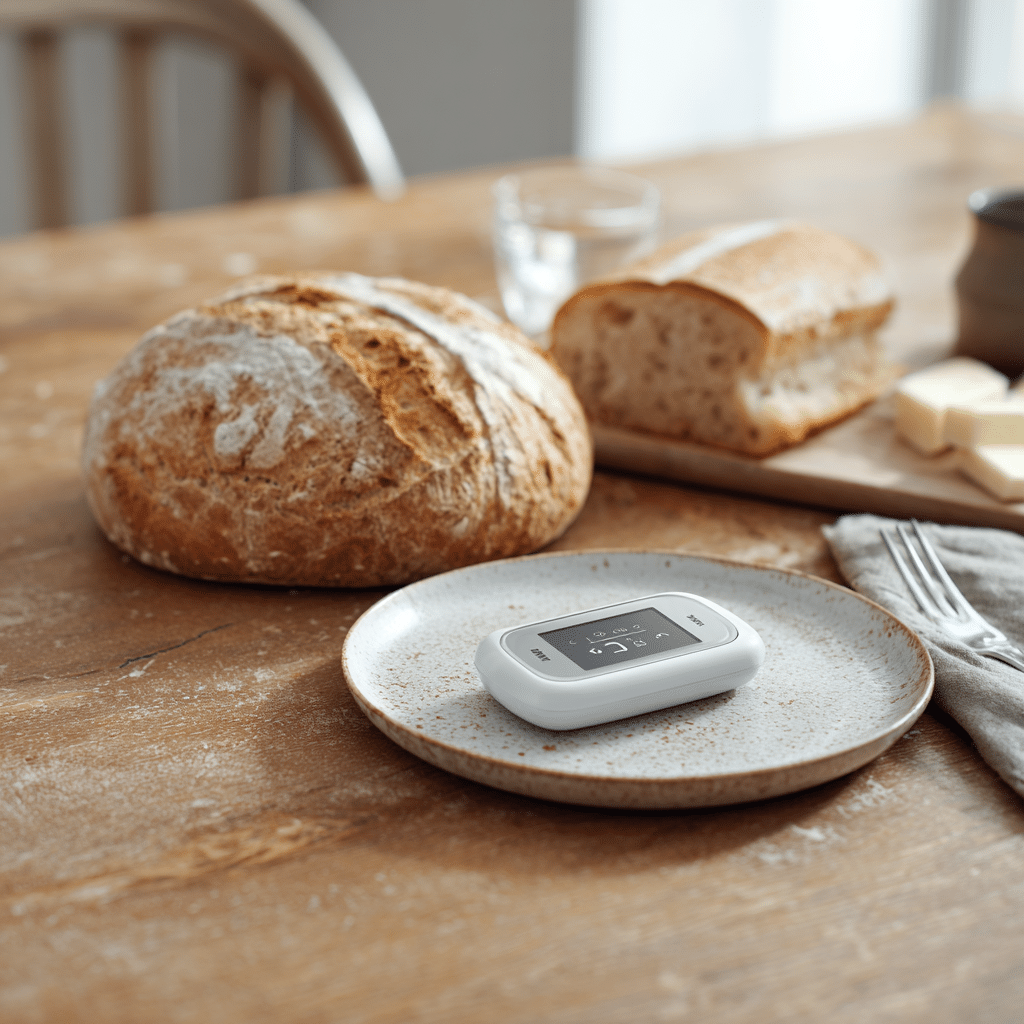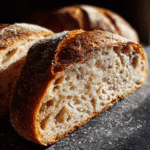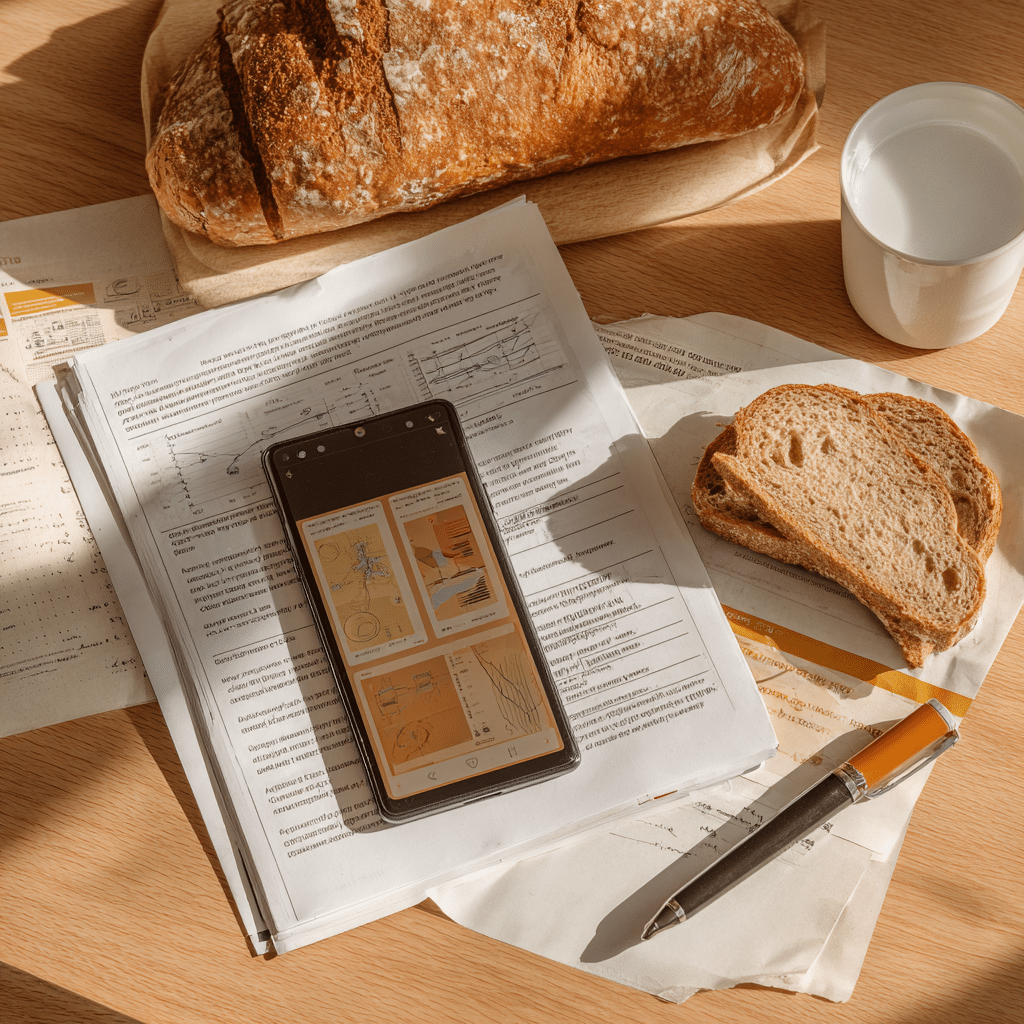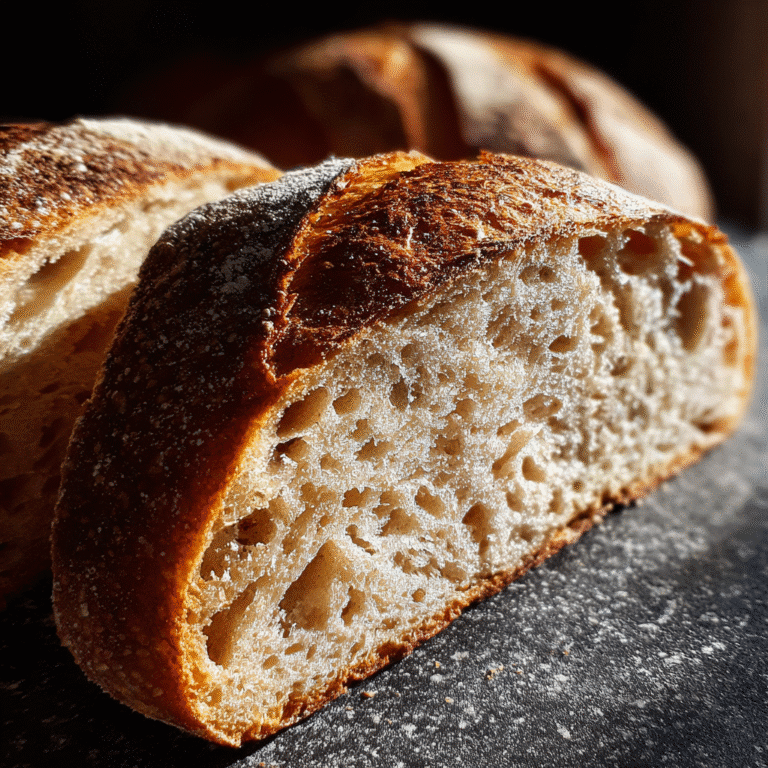Is sourdough bread healthy for diabetics? That’s one of the most common questions people ask when trying to navigate a low-sugar, blood-sugar-friendly diet. Bread has long been viewed as a dietary villain for diabetics but not all bread is created equal. Sourdough, thanks to its natural fermentation and unique glycemic properties, is gaining attention as a better alternative for blood sugar control.
Thank you for reading this post, don't forget to subscribe!In this comprehensive guide, we’ll break down how sourdough interacts with the diabetic body, compare it to traditional bread, and show you how to safely include it in your meals. Plus, we’ll answer common questions like how many slices are safe to eat and whether sourdough has hidden sugar. If you’re living with diabetes and missing bread, this is the insight-packed article you’ve been waiting for.
Learn more about healthy snack ideas using sourdough with sourdough pita chips
Table of Contents
Understanding Diabetes and Bread’s Impact
What Happens to Carbs in Bread for Diabetics
When someone with diabetes eats bread, the carbohydrates are quickly broken down into glucose, causing a rise in blood sugar. Unlike people with normal insulin response, diabetics can’t efficiently shuttle that glucose into cells. That’s why not all breads are equal some trigger spikes more than others.
White bread, for example, digests rapidly due to its refined flour, while whole grain or fermented breads break down more slowly. The key challenge for diabetics is choosing carbs that offer sustained energy without causing glucose spikes.

The Glycemic Index: Why It Matters
The Glycemic Index (GI) is a scale from 0 to 100 that measures how fast a food raises blood sugar. High GI foods (70 or more) cause rapid spikes. Low GI foods (55 or less) have a slower, more controlled effect.
Most white bread ranks high on the GI, while whole grains and fermented products like sourdough typically fall lower on the scale. That makes low-GI breads an essential part of diabetic diets.
| Bread Type | Average GI Score | Diabetic Friendly? |
|---|---|---|
| White Bread | 75 | ❌ High GI |
| Whole Wheat | 68 | ⚠️ Moderate GI |
| Sourdough | 54 | ✅ Lower GI |
How Insulin Resistance Changes Digestion
Insulin resistance common in Type 2 diabetes means the body doesn’t respond well to insulin, causing glucose to remain in the blood. High-carb foods worsen this resistance when consumed frequently.
But here’s the twist: fermented foods like sourdough contain beneficial acids and microbes that may actually improve insulin sensitivity. They work with your body, not against it, making them a unique option for those managing diabetes.
Check out gluten-free sourdough options on gluten-free sourdough bread
Print
Is Sourdough Bread Healthy for Diabetics? Uncover the Truth About Blood Sugar & Bread
- Total Time: 5 minutes
- Yield: 1–2 servings
Description
Explore the surprising benefits of sourdough bread for diabetics, including its low glycemic index, gut health perks, and how it stacks up against white and whole wheat breads.
Ingredients
- Whole grain sourdough bread (choose varieties with no added sugar)
- Rye sourdough bread (for low GI and fiber)
- Spelt sourdough bread (easy to digest)
- Optional healthy toppings: avocado, cottage cheese, peanut butter, leafy greens, eggs
- Portion control: 1–2 slices per day recommended
Instructions
- Choose authentic sourdough made with a natural starter, no added sugars, and whole or sprouted grains.
- Stick to 1 slice per meal (30–40g) and pair with healthy fats or protein.
- Eat sourdough during breakfast or lunch for best glucose control.
- Read bread labels carefully: avoid “enriched flour,” added sugars, and artificial flavors.
- Incorporate sourdough into balanced meals—open-faced sandwiches, toast with eggs, or snack with cottage cheese.
Notes
For best results, opt for homemade or artisan sourdough with long fermentation time and high fiber flours. Monitor your blood sugar to personalize your intake.
- Prep Time: 5 minutes
- Cook Time: 0 minutes
- Category: Health Guide
- Method: No-Cook
- Cuisine: Diabetic Friendly
What Makes Sourdough Different from Regular Bread?
The Sourdough Fermentation Process Explained
Unlike traditional yeast-leavened bread, sourdough is made through a natural fermentation process using wild yeast and lactic acid bacteria. This process takes time anywhere from 12 to 48 hours but that’s what sets it apart. During fermentation, the microbes pre-digest the starches, making the bread easier to digest and gentler on blood sugar levels.
This fermentation doesn’t just help with flavor it creates organic acids that slow down carbohydrate digestion, leading to lower post-meal blood glucose spikes. That’s a major plus for diabetics looking to control insulin response through diet.
Natural Acidity and Lower Glycemic Load
Thanks to its lactic and acetic acid content, sourdough has a naturally low pH. That acidity is a key reason why sourdough has a lower glycemic index than white or even whole wheat bread. These acids slow gastric emptying meaning glucose enters the bloodstream more gradually.
In fact, studies show that sourdough’s glycemic load (GL) is significantly lower than that of conventional breads. The GL measures not just how fast carbs convert to glucose, but how much they affect your blood sugar based on serving size. That’s crucial for diabetics who track carb counts daily.
Looking for inspiration? Try blueberry lemon sourdough bread
Comparing Sourdough vs White and Whole Wheat Bread
Let’s break it down. Here’s a side-by-side comparison that shows how sourdough stacks up against common bread types for diabetic health:
| Feature | White Bread | Whole Wheat Bread | Sourdough Bread |
|---|---|---|---|
| Glycemic Index | High (75+) | Moderate (60–68) | Low (around 54) |
| Fiber Content | Low | Moderate | Varies (higher if whole grain sourdough) |
| Sugar Impact | High | Moderate | Low |
| Fermentation | None | None | Yes |
| Blood Sugar Spike | Fast | Moderate | Slow |
Sourdough’s edge lies not only in its lower GI but also in its probiotic potential and digestibility. For diabetics, this means better post-meal glucose control and fewer insulin spikes.
Discover great ideas like sourdough discard soda bread
Is Sourdough Bread Healthy for Diabetics?
Benefits of Sourdough for Blood Sugar Control
So, is sourdough bread healthy for diabetics? The short answer is yes but let’s unpack why.
Because sourdough undergoes a slow fermentation process, it digests more slowly, helping to minimize bloo sugar spikes after meals. That’s vital for anyone managing Type 2 diabetes or prediabetes. Unlike most commercial breads, sourdough doesn’t flood your system with glucose immediately after eating. Instead, it offers a gradual energy release, which supports more stable insulin responses.
Additionally, the fermented structure improves starch digestibility, meaning your body works more efficiently without overreacting to carbohydrates. This makes sourdough a smart choice for diabetics looking to keep post-meal blood sugar within target range.
Scientific Research Backing Sourdough for Diabetics
Several studies confirm sourdough’s benefits for people with insulin resistance and Type 2 diabetes:
- A study published in Nutrition Research found that participants who consumed sourdough bread had significantly lower blood glucose responses compared to those who ate whole wheat or white bread.
- Another clinical trial revealed that sourdough fermentation enhances the formation of resistant starch, which behaves like fiber and helps with glucose regulation.
These results aren’t just hype they’re backed by science. When made with whole grain flour, sourdough’s benefits increase even more, delivering more fiber and nutrients without the blood sugar crash.

How Sourdough Affects Gut Health and Insulin Sensitivity
Gut health is closely linked to metabolic health and sourdough plays a role in both. Thanks to the lactic acid bacteria involved in fermentation, sourdough may promote the growth of beneficial gut microbes. These microbes are tied to better glucose metabolism and reduced inflammation, both of which are crucial in diabetes management.
The presence of prebiotics and postbiotics in sourdough (especially when made with whole grains) can improve gut lining function and boost insulin sensitivity over time. That’s something you don’t get with ordinary bread.
Don’t miss our sourdough discard biscuits for another creative way to enjoy the benefits of fermented bread.
Smart Ways Diabetics Can Include Sourdough Bread in Meals
Ideal Portion Sizes and Serving Frequency
When it comes to diabetes, portion control is everything even with healthier breads like sourdough. The key is to balance enjoyment with blood sugar safety.
For most people with diabetes, one slice (about 30–40 grams) of sourdough bread per meal is a safe starting point. This small serving keeps your carb count in check while still offering the benefits of fiber and resistant starch.
Here’s a quick guide:
| Meal Type | Ideal Sourdough Portion | Notes |
|---|---|---|
| Breakfast | 1 slice (30–35g) | Pair with protein or healthy fats |
| Lunch Sandwich | 2 slices (max 70g) | Add fiber-rich veggies |
| Snack/Side | ½ slice (15–20g) | Best combined with lean protein |
Too much of any bread even sourdough can lead to carb overload. Spread your intake across the day instead of consuming multiple slices in one sitting.
Best Times to Eat Sourdough to Avoid Glucose Spikes
Timing matters. To avoid blood sugar spikes, it’s best to eat sourdough during:
- Breakfast or lunch when your metabolism is active
- Post-workout meals where your insulin sensitivity is slightly elevated
- Never alone always with fiber, fats, or protein
Try pairing sourdough toast with avocado and eggs, or using it for an open-faced turkey sandwich with leafy greens. These combos slow digestion, helping prevent rapid glucose increases.
Healthy Toppings and Pairings with Sourdough
Sourdough bread is a blank canvas but what you add to it can make or break your glycemic control.
Here are diabetic-friendly toppings and pairings that boost fiber, protein, and healthy fats:
| Topping | Benefit for Diabetics |
|---|---|
| Avocado + boiled egg | Packed with healthy fat and protein |
| Cottage cheese | Low-carb, high-protein dairy option |
| Natural peanut butter | Slows carb absorption with healthy fat |
| Sautéed spinach | Adds fiber and iron |
| Smoked salmon | High protein and omega-3s |
Avoid sweet spreads, jams, and high-sugar peanut butters. And skip large amounts of butter, which can add saturated fat without benefits.
Explore another great option with cloud bread breakfast sandwich for a lower-carb alternative.
Top Sourdough Bread Options for Diabetics
Whole Grain, Spelt, and Rye-Based Sourdoughs
If you’re managing diabetes, not all sourdough is created equal. While the fermentation process helps reduce the glycemic load, the type of flour used still plays a huge role.
Best choices for diabetics:
- Whole Grain Sourdough – Made with whole wheat or wholemeal flour, this type offers more fiber, vitamins, and a slower carb release.
- Spelt Sourdough – Spelt is an ancient grain that’s lower in gluten and has a slightly nutty flavor. It’s also easier to digest for many people.
- Rye Sourdough – Dense and hearty, rye sourdough is lower in sugar and digests slower, making it ideal for stabilizing blood sugar levels.
These breads are typically more nutrient-dense, rich in resistant starch, and have stronger blood sugar benefits than white flour sourdough.
| Bread Type | Fiber (per slice) | Estimated GI | Best For |
|---|---|---|---|
| White Sourdough | 1g | ~65 | General enjoyment |
| Whole Grain | 3–4g | ~53 | Blood sugar control |
| Spelt Sourdough | 2–3g | ~55 | Digestive comfort |
| Rye Sourdough | 4g+ | ~50 | Insulin sensitivity |
Store-Bought vs Homemade Sourdough Bread
Store-bought sourdough is convenient, but not always authentic. Many commercial loaves labeled “sourdough” are made with yeast and vinegar to mimic the sour taste, not real fermentation. These breads won’t deliver the blood sugar benefits you expect.
What to look for on the label:
- Ingredients: Should include only flour, water, and salt (plus starter)
- No added sugar or yeast
- Longer fermentation times listed
- Look for the phrase: “naturally leavened”
Homemade sourdough or those from artisan bakeries are more likely to be naturally fermented, using wild yeast. Making your own bread gives full control over flour types and fermentation time, which is ideal for blood sugar management.

How to Read Bread Labels for Diabetic Safety
Diabetics must become ingredient detectives. Here’s what to look for on any sourdough bread label:
- Fiber: At least 2g per slice is ideal
- Sugar: Should be 0g added sugar
- Carbs: Stick to under 15g per slice
- No refined flour: Look for 100% whole grain or rye
- Serving size: Watch portion control large slices add hidden carbs
Avoid labels that say “enriched flour,” “caramel color,” or “dextrose,” which indicate processed ingredients that can trigger glucose spikes.
So, Is Sourdough Bread Healthy for Diabetics?
To wrap it up, yes—sourdough bread is healthy for diabetics, especially when it’s made from whole grain, rye, or spelt flour and fermented naturally. Its low glycemic index, high digestibility, and gut-friendly bacteria make it a superior choice to conventional bread. With the right portion size, strategic meal pairing, and careful label reading, sourdough can absolutely be part of a balanced, blood-sugar-friendly diabetic diet.
Don’t miss our sourdough discard soda bread if you’re looking for another way to enjoy diabetic-friendly baking at home.
FAQ: Is Sourdough Bread Healthy for Diabetics?
Can a diabetic eat sourdough bread?
Yes, a diabetic can eat sourdough bread—in fact, it may be a better option than conventional white or wheat bread. Thanks to the natural fermentation process, sourdough typically has a lower glycemic index, meaning it causes a slower rise in blood sugar. It’s also easier to digest and may support better insulin sensitivity, especially when made with whole grain or rye flour.
The key is moderation and proper pairing with protein, fiber, or healthy fat to further slow glucose absorption.
Which bread is best for diabetics?
The best bread for diabetics is one that is:
• Low on the glycemic index (GI)
• High in fiber
• Free of added sugars
• Made with whole or sprouted grains
Top diabetic-friendly breads include:
• Whole grain sourdough
• Rye sourdough
• Sprouted grain bread
• 100% whole wheat with no added sugar
Always read labels carefully. Bread made with real sourdough starter and fermented for 12+ hours offers added benefits for blood sugar control.
How many slices of bread can a diabetic eat per day?
There’s no one-size-fits-all number, but 1 to 2 slices of sourdough bread per day can generally fit within a diabetic diet, depending on your personal carb goals.
Tips for safe bread intake:
• Monitor blood sugar after eating
• Spread slices across meals (e.g., one for breakfast, one for lunch)
• Pair each serving with fiber or protein to blunt sugar response
• Adjust based on physical activity levels
Remember: quality and quantity both matter. Two slices of high-fiber sourdough are better than one slice of white bread.
Does sourdough bread have a lot of sugar?
No, traditional sourdough bread does not contain a lot of sugar. In fact, when made properly, most of the starch in the flour is partially broken down during fermentation, leaving less impact on blood sugar levels.
Most artisan or homemade sourdoughs have 0g of added sugar. However, always check labels, as some commercial brands add sugar or honey to speed fermentation or enhance flavor.
When choosing sourdough:
• Look for “no added sugar” on the nutrition label
• Skip flavored or sweetened varieties (e.g., cranberry-walnut sourdough)
• Check carb and fiber ratios per slice
Follow us on Facebook: Recipe by Clara

